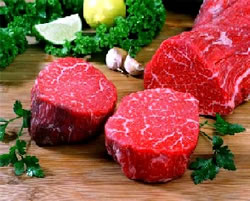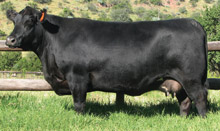Growing up in the city has its advantages but on the flip side, my knowledge on farm animals are pretty limited. Don’t get me wrong, I know all about menagerie thanks to a few forced school trips to the zoo. I just don’t know a lot about the different type of breeds out there. I therefore fell of my chair when I discovered that Angus is not the hot new chef at a French restaurant in Stellenbosch. It’s in fact a breed of cattle, much used in beef production.
The breed was developed from cattle native to the counties of Aberdeenshire and Angus in Scotland and are known as Aberdeen Angus in most parts of the world. What makes it so special? Apart from being the biggest breed of cattle in the world, they are also super tasty. It’s an extremely flavourful, tender and juicy piece of meat and you have to be a very bad cook to screw things up in the kitchen. Another thing that makes the beef special is the DNA softness gene found in the cattle. The fat distribution (marbling) in Angus beef is medium to high but the texture of the marbling is fine. Marbled beef is preferable to layered fat beef because marbled fat melts as it cooks. These white flecks ensure consistent flavour and juiciness with every bite.
The important thing when purchasing this exquisite piece of meat is to make sure that it’s certified Angus beef. The “Certified Angus Beef” brand was set up in 1978 by the American Angus Association. The purpose of the association is to control race standards and therefore the beef must pass 10 stringent quality specifications in order to earn the brand’s premium mark.
The first importation of Angus into South Africa happened in 1895 when ten Aberdeen-Angus cattle arrived on a farm in the Free State. It was not long before the other farmers noticed these handsome animals and pretty soon another consignment of bulls were shipped in from Scotland.
The breed is famous for its small calves at birth with an average birth mass of 35.1 kg. Calves are slaughtered between the ages of 5 to 8 months and by then they weight around 300kg. Angus cattle are registered at birth but registration certificates are valid only after visual inspection of the animal by a Society official. The colour of thorough breed is either red or black, without any spots. They also don’t have any horns and because of this many people referred to them as “hornless freaks” back in the day.
To date, the highest price paid for a Angus in South Africa is R210 000. The cow goes by the name of Dreamcatcher and this black beauty now belongs to the Lammerskraal Angus Stud farm outside Ceres.
 The chairman of Agri SA, Klasie Jacobs believes that it’s important for breeders to get their animals registered in order to maintain the quality of the beef. Today there are +\- 3000 registered beef farmers in South Africa who belongs to the South African Angus Society. The main aim of the society is to manage the marketing of the beef in the country and also to help stud farm breeders to get their hands on the best bulls, as fast as possible. Farmers who want to become members, register or auction their animals, can contact the breed director, John Boulle.
The chairman of Agri SA, Klasie Jacobs believes that it’s important for breeders to get their animals registered in order to maintain the quality of the beef. Today there are +\- 3000 registered beef farmers in South Africa who belongs to the South African Angus Society. The main aim of the society is to manage the marketing of the beef in the country and also to help stud farm breeders to get their hands on the best bulls, as fast as possible. Farmers who want to become members, register or auction their animals, can contact the breed director, John Boulle.
Thanks to this society, it won’t be long before the consumer can get their hands on genuine certified South African Angus beef, but for now it’s only available at establishments who is licensed to buy certified Angus beef. Cafe Dijon in Stellenbosch makes one mean Angus sirloin steak. Try it with a glass of Zorgvliet Merlot, it’s to die for!
The base price for a fillet is around R125 per kilo and between R60 – R70 per kilo for sirloin.




